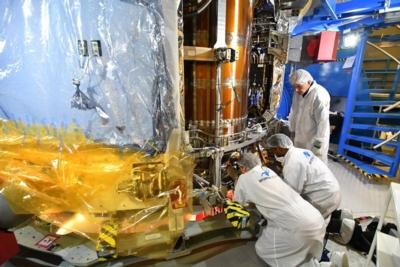Sat, Sep 22, 2018
Work On Second Spacecraft Is Well Underway
Last week at the Airbus integration hall in Bremen, Germany, technicians installed the last radiator on the European Service Module for NASA’s Orion spacecraft marking the module’s finished integration.

ESA’s European service module will provide power, water, air and electricity to NASA’s Orion exploration spacecraft that will eventually fly beyond the Moon with astronauts. The European Service Module is now complete for Orion’s first mission that will do a lunar fly-by without astronauts to demonstrate the spacecraft’s capabilities.
Much like closing the hood of a car, with the radiators in place technicians can no longer access the internals of the European service module, symbolically ending the assembly and integration of the module that will fly further into our Solar System than any other human-rated spacecraft has ever flown before.
Technicians worked 24 hours a day in three shifts to complete the service module’s assembly which is now going through the last stages of its extensive testing. Engineers will put the module through its paces with functional tests that include checking the newly installed radiators and testing the propulsion system with its intricate pipelines that deliver fuel and oxidiser to the spacecraft’s 33 engines.
Once complete the service module will be packed and flown to NASA’s Kennedy Space Center in Florida, USA. Orion’s solar wings will be shipped separately, also from Bremen. In the USA the module will be stacked together with NASA’s Crew Module Adaptor and Crew Module, the first time the complete spacecraft will be on display.
More tests await the Orion spacecraft at NASA’s Plum Brook facility where it will be put in the world’s largest vacuum chamber to simulate spaceflight as well as being subjected to acoustic tests to simulate the intense vibrations Orion will endure when launched on the world’s largest rocket, NASA’s Space Launch Systems.
Meanwhile technicians in Bremen are not resting as work on the second European Service Module is already well under way. The structure is complete and over 11 km of cables are being meticulously placed in preparation for the computers and equipment that will keep astronauts alive and well for the second Orion mission called Exploration Mission-2.
(Image provided with ESA news release)
More News
Also: Vertical Flight Society, NBAA Maintenance Conference, GA Honored, AMT Scholarship For the first time, students from Embry-Riddle’s Daytona Beach, Florida, campus took t>[...]
Hazardous Weather Information Summary of significant meteorological information (SIGMET/WS), convective significant meteorological information (convective SIGMET/WST), urgent pilot>[...]
"The need for innovation at speed and scale is greater than ever. The X-62A VISTA is a crucial platform in our efforts to develop, test and integrate AI, as well as to establish AI>[...]
(FAA) Inspector Observed That Both Fuel Tanks Were Intact And That Only A Minimal Amount Of Fuel Remained In Each Analysis: According to the pilot, approximately 8 miles from the d>[...]
“Pyka’s Pelican Cargo is unlike any other UAS solution on the market for contested logistics. We assessed a number of leading capabilities and concluded that the Pelica>[...]
 Airborne-Flight Training 05.09.24: ERAU at AIAA, LIFT Diamond Buy, Epic A&P
Airborne-Flight Training 05.09.24: ERAU at AIAA, LIFT Diamond Buy, Epic A&P ANN's Daily Aero-Term (05.07.24): Hazardous Weather Information
ANN's Daily Aero-Term (05.07.24): Hazardous Weather Information Aero-News: Quote of the Day (05.07.24)
Aero-News: Quote of the Day (05.07.24) NTSB Final Report: Cessna 150
NTSB Final Report: Cessna 150 Aero-News: Quote of the Day (05.08.24)
Aero-News: Quote of the Day (05.08.24)



